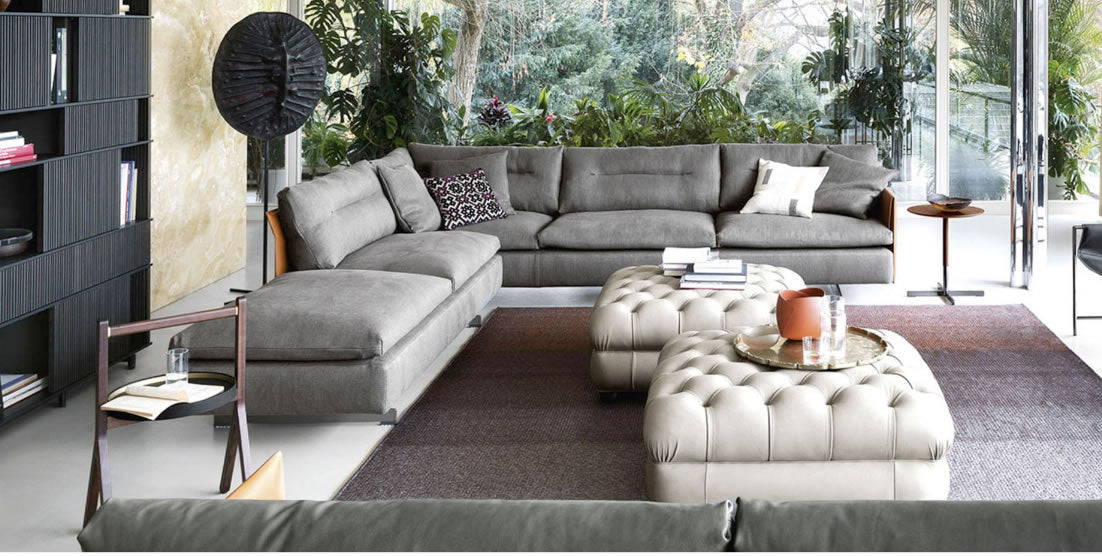Poltrona Frau – Modern and Contemporary Italian Furniture
Poltrona Frau – Modern and Contemporary Italian Furniture




About Poltrona Frau
Founded in 1912, Poltrona Frau has been making quality craftsmanship Italian furniture and leather products for over a hundred years.
The company was founded by Lorenzo "Renzo" Frau, and the company's name is a combination of the Italian name for an armchair and the surname of its founder. Although the company is no longer in the Frau family, the name, synonymous with design ingenuity and quality products, has remained intact throughout the years.
Poltrona Frau specializes in automotive and interior leather seating. Its craftsmen use a 21-step leather tanning process that enables surface scratches not to reveal an underlying lining because the entire grain of the leather is dyed through and through. An astounding 95% of the company's products are still made by hand.
Poltrona Frau Origins

Renzo Frau
Renzo left his homeland of Sardinia for military service in Milan before settling down in Turin, Italy, with wife Savina Pisati. In Turin, Renzo initially worked as a sales representative for Gribaudi. He later worked for faux leather manufacturer Dermoide Patent.
He discovered the Chesterfield model armchairs while working in Great Britain and immediately recognized the design potential, but he was also drawn to the French and Central European armchair designs. It was only natural that his equally artistic and craftsman-oriented mind decided to create his own design studio to work on creating ground-breaking and standard-setting designs. Before long, Poltrona Frau was a collaboration of intellectuals, craftsman, and artisans, and churned out one successful model after another.
Savina Pisati would initially take the reins of the company as Renzo fought in WW1 and then again following Renzo's untimely death in 1926. During her first stent in leading the company, Savina was instrumental in getting the Poltrona Frau armchairs into some of the most famous and influential buildings of Italy, including those used by the royal family. As she took the helm following her husband's death, she was able to bring to life an archive of design project specs Renzo left behind.
In 1941, Savina Pisati handed the reins of the company over to Roberto Canziani, her son-in-law. It left the family's hand in the early 1960s when The Nazareno Gabrielli Group purchased it and named Franco Moschini as chairman. Tolentino, Italy became headquarters for Poltrona Frau.
Since then, Poltrona Frau has remained an international brand icon and expanded its portfolio. It's the parent company to a number of other Italian companies, including Cappellini, Cassina, Alias, Nemo Lighting, Ceramica Flaminia and Fish Design.
Poltrona Frau Leather


Renzo Frau was able to take the idea of a simple leather seat cover and transcend it into the foundation for an international impeccable standard of success.
Pelle Frau® leather is not only a historic story of success and values. It’s also synonymous with setting the standard for quality, comfort, prestige, and elegance. Pelle Frau® leather's tactile, visual, and aesthetic qualities and its durability stems from a commitment to preserve the natural softness of only the finest coats. Only natural full-grain leather from the dermis, the most prized part of the coat, is used.
Poltrona Frau laboratories perform a number of sensory, physical, and mechanical tests prior to a hide being selected and admitted to the production phase. This highly-selective process is why Pelle Frau® leather is known for its resistance to stains and rubbing and consistent quality of superior touch and appearance.
The sensory pleasure of Pelle Frau® leather comes from a unique 20-step production phase, which is more than twice the accepted number of steps in furnishing leather production. Tanning processes are combined with chrome treatments to preserve and strengthen the chemical and biological stability of the leather, which in turn guarantees the leather's flexibility and softness.
Pelle Frau® leather consists of eight distinct collections: Nest; Soul; Heritage; Century; Cavallino; Saddle; and, its latest additions, Cuoietto and Safari. In 1987, the Color System Frau® was created to control the range of shades available for its extensive 96 colors. New shades are continually developed and added to the system. All shades are presented per variation of materials used in production, including down, horsehair, raffia, and wood. In addition, colors are organized by “families” along a scale of brightness, with shades ranging from white to black, light to dark.
Iconic Furniture from Poltrona Frau

Vanity Fair Chair
Undeniably an icon of Italian craftmanship, the Vanity Fair chair has been an epitome of Poltrona Frau design since first appearing in its 1930 catalog as the official “model 904.” In 1984, the chair became known simply as “Vanity Fair” and its rounded arms and backrest continued to be renowned the world over as an archetype of excellence in club-style seating.
Originating with the archived drawings left to Savina by her late husband, Renzo, the Vanity Fair has undergone many design configurations over the years, never losing its easily recognizable iconic style. One of the reasons is its structure and quality of materials used. With a seasoned beech frame, biconical springs of steel, and belts of jute, the Vanity Fair is as beautiful as it is solidly constructed. The quality continues with a goose-down seat cushion and chair padding of finest hand-shaped vegetable fibers and rubber-treated horsehair. The aesthetic is enhanced with tacks fully-covered in leather, dark-stained beech legs, and 24 Kt. gold-plated, numbered plaque.



Chester Line
What started as a singularly modern take on a classic design, the Poltrona Frau’s iconic two-seat Chester sofa has been joined by the Chester Line, a modular interpretation of traditional features and style. The Chester Line includes five fully interchangeable pieces: chaise lounge, armchair, poufs, and left or right corner sofas. Elements consistent with both the Chester and Chester Line are the traditional capitonné, as seen on tightly tufted backs and gently spiraling armrests, along with non-tufted seat cushions. One recognizable difference, however, is the lack of capitonné on the base of furnishings with the Chester Line. It’s the removal of certain details that allows the Chester Line to work beautifully within modern living spaces.
Armrests and backrests are also removed on certain pieces, creating a lighter, airier feel to the substantially constructed furnishings. Details such as aluminum legs in a sleek, blade-like shape and single-cushioned seats on sofas add to the contemporizing of the classic. The Chester Line coordinates with a variety of other pieces, equally timeless and modern in function and style: the Fidelio side tables and lamp seamlessly lend their architectural lines for endless arrangement possibilities. Like the Vanity Fair chair, the Chester Line’s support structure includes seasoned beech frames, biconical springs of steel, and belts of jute, along with padding of hand-shaped vegetable fibers and rubberized horsehair. In addition to goose-down, the seat cushions include polyurethane foam for added firming and stabilizing.
Upholstery options are plentiful from the Pelle Frau® leather collections of Nest, Heritage, Century, and Cuoietto, and can be coordinated with the Poltrona Frau fabrics, all using the Color System Frau®. Additional furnishing leg options are available by request, including brushed aluminum, dark-stained beech, black lacquered beech, and high or low lengths.

Archibald Chair
Originally created by Jean-Marie Massaud as an icon for meditation and relaxation, the Archibald Chair has now been updated on a grand scale: the Archibald King. All Archibald chairs share the distinctive and large headrest, as well as the softened, integrated lines to the back and arm rests. Contrasted stitching embellishes the modern edges and surfaces of the Pelle Frau® leather upholstery, adding an element of refined elegance to each piece.
The Archibald Chair has a steel frame atop a four-foot base in cast aluminum with springs of elastic belts. Tubular steel completes the structure and leggings with a finish in gunmetal grey. Molded polyurethane foam is used as padding throughout with shaped polyester foam wadding added to areas requiring more cushioning for extra comfort.






